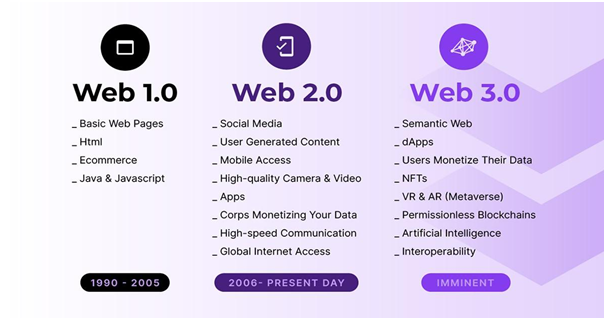WEB 3.0
Context: Recently the Union Minister for Finance and Corporate Affairs asked banks to be more digital savvy and give immediate priority to use Web3 and artificial intelligence technology in fraud detection and to generate early warning signs in case of an unforeseen event.
About WEB 1.0 and 2.0
- Web 1.0 is considered the first phase, where most of the web accessible to people was Read-only, allowing users to simply read content and not really interact with it. This included content like news sites, portals and search engines.
- With Web 2.0, the major new aspect that came into play is interaction. Concepts like ‘liking’ something you read on social media, ‘commenting’ on videos and sharing interesting content became prevalent trends.
WEB3.0
- Decentralisation
- This is basically a concept that takes power and/or control away from a single person or body, and gives it to the masses. A good example of this is cryptocurrency.
- In Web 2.0 services may crash when the servers of a particular platform go offline at the headquarters. This, however, wouldn’t be possible with a Web 3.0 platform that essentially is run by everyone using it, in multiple, simultaneously updated copies via a P2P (peer-to-peer) network.
- Web 3.0 is also expected to change how monetization and marketing will work on the larger scale, with Artificial Intelligence (AI) powering tech like Natural Language Processing (NLP) which is set to make interacting with computers more like interacting with fellow humans, rather than with a machine.
Some potential uses of Web 3.0
- Decentralised applications: Web 3.0 facilitates the development of decentralised applications (DApps) that run on blockchain technology. These DApps can offer new business models, including decentralised marketplaces, social networks, and content sharing platforms.
- Improved search results: With Web 3.0, search engines can understand the context behind queries and return more relevant results. By analysing the content of web pages, search engines can categorise them and provide more accurate and useful results.
- Personalization: With Web 3.0, personalized content can be delivered to users based on their preferences and behaviors. This allows for more targeted advertising and marketing, but it also enables more personalized experiences for users.
- Data ownership and privacy: Web 3.0 aims to give users more control over their data. With decentralized technologies like blockchain, users can own and control their data, allowing them to decide who can access it and how it’s used.
- Smart contracts: Web 3.0 enables the creation of smart contracts, which are self-executing contracts with the terms of the agreement between buyer and seller being directly written into lines of code. Smart contracts can automate business processes and reduce the need for intermediaries.
| Practice Question
1. What is WEB 3.0? What are its potential uses? |




